You will be redirected to a Leads.io registration page.

Get up to 3 quotes from our selected suppliers by filling in only 1 form

Save money by comparing quotes and choosing the most competitive offer

Our service is 100% free and with no obligation
- GreenMatch.com
- HVAC
Heating, Ventilation, and Air Conditioning (HVAC) System Guide 2025
What is the Best HVAC System for Your Home?
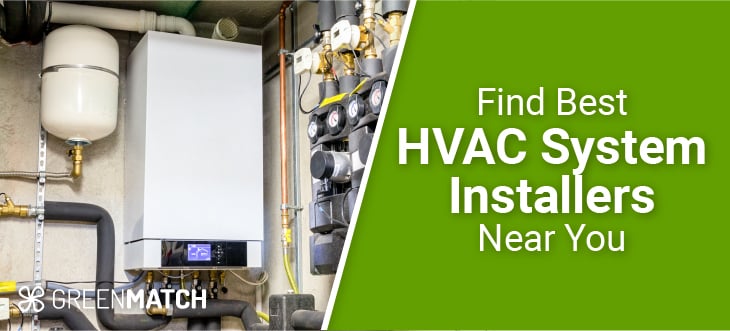
HVAC stands for Heating, Ventilation, and Air Conditioning. According to a 2020 Resident Energy Consumption Survey, around 66% of homes across the US use central heating and cooling (HVAC) systems. This system offers thermal comfort by regulating heating, cooling, and ventilation inside your home. It controls temperature, humidity, and air movement which creates a comfortable environment within your home. It also maintains good indoor air quality in your home, keeping your surrounding environment healthier at all times.
As the name suggests, the main components of an HVAC system include heating, ventilation, and air conditioning. There are also filters, humidifiers and thermostats. There are several types of HVAC systems that you can install in your home. The question is where and how to find the right system for your home, one that checks all the boxes.
If you’re looking for a replacement system or a new HVAC system, you’ve come to the right place. GreenMatch can get you in touch with up to three certified installers and their quotes for you to compare. All you have to do is click on the button below and forego the tedious, hours-long process of calling installers one by one and requesting quotes.
Fill in the form in just 1 minute
The Different Components of an HVAC System
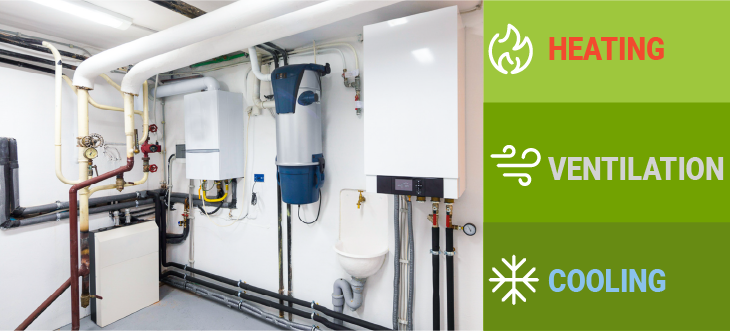
An HVAC system is primarily responsible for regulating and controlling the temperature inside your home, as we learned above. The three main components of an HVAC system are heating, ventilation, and air conditioning. We have briefly discussed these components below:
Heating
The heating component of the HVAC system maintains a comfortably warm temperature inside your home, especially during colder months. A heating system generates heat and distributes it throughout your home through a system of ducts, pipes, or radiators. With the heating system, you have several options between going green and systems that consume fuel or energy.
Furnaces and boilers are two of the most commonly used heating components in an HVAC system. However, you can also opt for other heating systems such as heat pumps, geothermal heat pumps, or ducted heating systems.
Ventilation
Ventilation basically means an exchange of stale indoor air with fresh outdoor air to improve indoor air quality. The ventilation system helps remove pollutants, odors, and excess moisture from the air, replacing it with cleaner, oxygen-rich air for healthier indoors. There are different types of ventilation systems that maintain the indoor air quality of your home.
The two main types of ventilation systems are natural ventilation and whole home (mechanical) ventilation systems. Usually, the whole home ventilation systems are a part of HVAC systems that often work in conjunction with natural ventilation systems to regulate and control indoor air quality. The four different types of mechanical systems include spot ventilation, supply-only system, exhaust-only system, and balanced ventilation system.
Air Conditioning
Air conditioners (AC) maintain comfortably cooler temperatures inside your home, especially during summer. It works by removing the heat from inside your home and blowing cool air inside your home. It also maintains humidity levels inside your home. The basic mechanism or working of an AC system is similar to that of your refrigerator.
Just like with the heating systems, you have several air conditioning systems to choose from. These include central air conditioning systems, split AC, and ductless mini-split air conditioners, along with other individual options. Each of these systems has an outdoor unit that vents heat out from the inside of your home. Most air conditioning systems today work as both heating and cooling systems.
There are several factors that the selection of these systems is dependent on. These include the size of your home, your budget, and the climate of the region you’re living in, among others. Often, deciding on a system that would work best for you is difficult. Also, knowing what types of HVAC systems are available in the market is important.
Consulting manufacturers or certified installers can make this process simpler and easier for you. However, finding the right installer is also just as daunting a task as deciding on the best HVAC system. You end up calling installer after installer, explaining your requirements, and requesting quotes. GreenMatch makes this process simpler. Simply click on the button below and we’ll get you free quotes from up to three installers to compare with no obligation.
Fill in the form in just 1 minute
Types of HVAC systems
As we know by now, an HVAC system is an amalgamation of heating, ventilation, and air conditioning systems. Each of these systems often works in conjunction with each other. These components may also perform dual functions of heating and cooling your home. There are three major types of HVAC systems that you should know about. Of course, there are other system options available. However, this again differs from manufacturer to manufacturer.
Split HVAC System
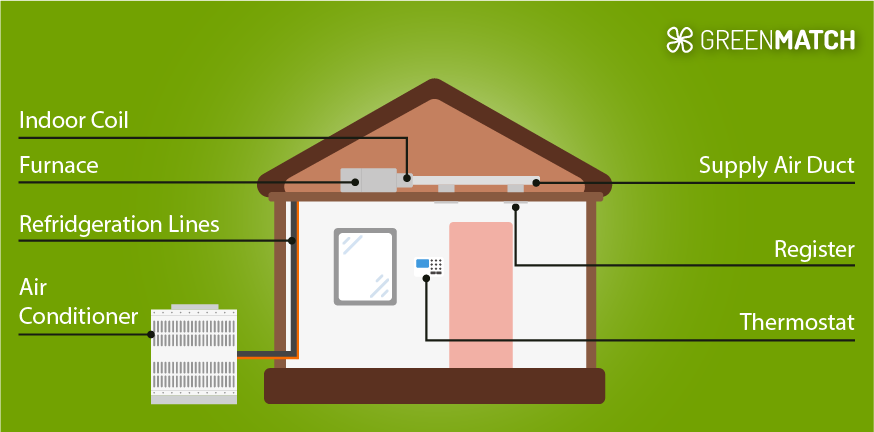
A split HVAC system is the most common type of system used in homes and small commercial buildings. The system consists of two main components: an indoor unit with the evaporator coil and a blower, and an outdoor unit with the compressor and condenser coil. Both units are connected via ducts, also known as refrigerant lines. A split HVAC system can provide you with both heating and cooling.
Packaged HVAC System
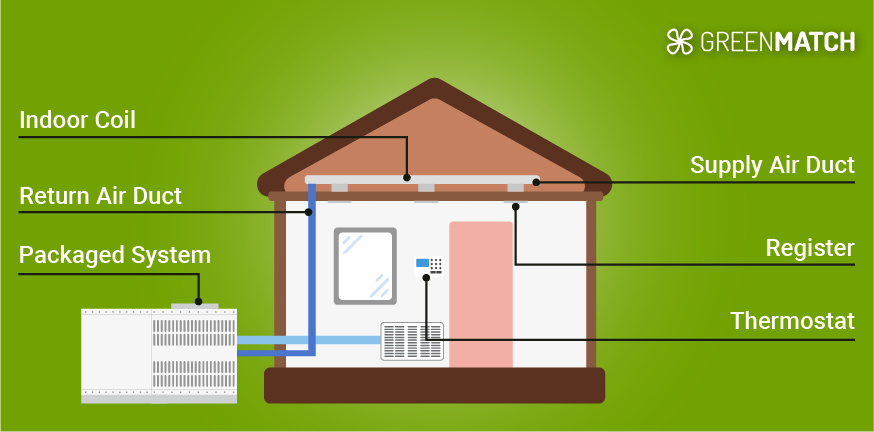
A packaged HVAC system is one where all components of the system – heating and cooling units, are encased in a single unit. This unit is usually installed on the roof or beside the building on a concrete pad. However, this type of system is more common in small commercial buildings, offices, and retail spaces. It is especially so where limited indoor space is available for equipment installation.
Heat Pump System
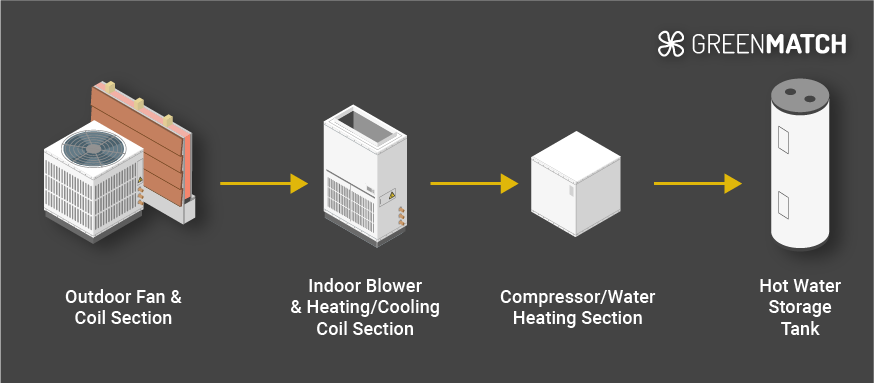
Heat pump systems are versatile HVAC systems that can provide both heating and cooling. When in heating mode, they extract heat from the outdoor air and transfer it indoors. On the other hand, when in cooling mode, it transfers heat from the indoors to the outdoors, cooling your home. The three main types of heat pumps that are commonly seen in households are air heat pumps, water heat pumps, and geothermal heat pumps.
Find the Best HVAC System Installation Quotes

As we have learned so far, you have several options when choosing an HVAC system for your home. Comparing quotes from different manufacturers is in your interest. This is because services, features, and costs often differ between manufacturers. Getting quotes from different manufacturers and installers, whether local or global, can assist you in making an informed decision with respect to your investment.
GreenMatch can make the hour-long process of calling installers one by one simpler. Click on the button below and we will match you up with up to three certified installers and get their quotes for you to compare.
Fill in the form in just 1 minute
Frequently Asked Questions
An HVAC system stands for heating, ventilation, and air conditioning. This system is responsible for heating and cooling your home, maintaining, and regulating comfortable temperatures all year round.
Split HVAC systems are the most commonly used for heating and cooling purposes in homes across the US.
An HVAC system is responsible for both heating and cooling your home. An air conditioning system, on the other hand, works only towards cooling your home.
We strive to connect our customers with the right product and supplier. Would you like to be part of GreenMatch?

